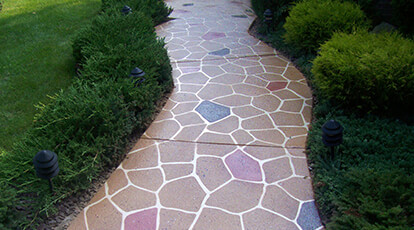You can, if desired, Cut the stain and apply more than one coat may add to the marbling effect that stains are known and loved for. However, staining at 100% strength cuts labor costs and still creates a coloring effect with highly favorable results. If too much water is added, stain color may not be as brilliant as less acid is reacting with the surface.
Topics: DIY
Should I cut the stain?
Troubleshooting VIVID™ Acid Stain: Stain won’t take.
Reason: If the stain is not fizzing it may signify an unsuccessful chemical reaction. Stain reacts with lime and other latents within concrete substrate. When a reaction does not occur it could signify that the concrete may be too old, washed out and/or chemical residue or oils may be interfering and preventing a proper reaction. If the stain is pooling on top of the substrate, a sealer or other curing agent may still be on the concrete preventing penetration.
Solution: Make sure any chemicals on the concrete are removed. If the concrete is old or washed out or you are dealing with a very tight power trowel, it may help to add no more than one cup of muriatic acid to one gallon of Chemical Stain Note: do not add muriatic acid to turquoise; doing so will cause an unfavorable result.
Troubleshooting VIVID™ Acid Stain: “Wrong Color”
Reason: Due to the unpredictability of chemical stains and the multiple variances that can occur, the same acid color can react differently.
Solution: It is beyond the ability of Concrete Coatings, Inc. to predict or guarantee an acid stain’s reaction to concrete or other cementitious substrate. The responsibility rests solely with the applicator to perform a test on a small inconspicuous area of the job to get an idea of how the stain will react and look on your specific job site. Notwithstanding these measures, it is impossible to guarantee color depth and chemical reaction throughout the entire substrate.
What coverage should I expect from Micro-Tek™ Micro-Toppings?
The first application can be applied with a squeegee or trowel at about 200 sq. ft. per bag of RG and SG micro toppings. Coverage with additional coats of smooth grade, usually applied with a trowel, increases due to a smoother surface with less voids etc. The second and subsequent coats are usually applied at 300-600 sq. ft.
How much water do I add per bag of Micro-Tek™ Micro-Toppings?
1 ½ - 2 gallons of water for rough grade micro topping and 2 ½ gallons of water must be added to each bag of smooth micro topping. Once the water is added it is important to allow time for the polymers to become saturated. Wait 5-10 minutes; then remix and apply.
Is it necessary to apply rough grade prior to applying smooth grade micro topping?
Yes. You must put a base coat down prior to applying a smooth grade finish. Smooth micro-toppings are not designed for repair, spalling and uneven surfaces. We recommend the use of a single coat of RG micro-topping or the use of our G-100 and Duraset™ polymer to prior to applying the smooth grade topping.
Are your coloring systems compatible with the overlay?
Yes. All 28 colors in our C Series integral color work well with our overlay. You may also stain or dye the material using our VIVID™ Acid Stain or QuickDye™.
When can I stamp Stamp-Tek™ Stampable Overlay?
Stamp the material when it is firm, not squishy. Unlike concrete, Stamp-Tek™ Stampable Overlay does not require heavy pressure or extreme tamping. Apply only enough even pressure to seat the mat and provide an impression. Allow 36 hours before foot traffic.
How do I remove the lines from the gauge rake?
Concrete Coatings, Inc. recommends the use of a funny or magic trowel.
How do I spread out and even Stamp-Tek™ Stampable Overlay?
We recommend the use of a gauge rake purchased from your local supply store.
